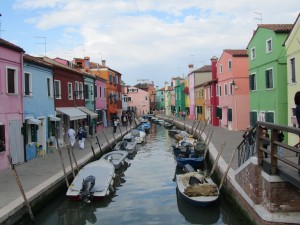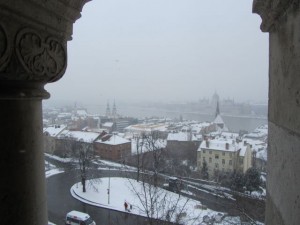Serbia and the Serious World We Live In Today
August 26th, 2016Warning: Not your normal light, entertaining post.
I felt the heaviness in the air immediately. The mood of the country seemed dark, just like the rain-filled clouds that greeted me when I arrived to Serbia. Spring had definitely not sprung and the weather in Belgrade was unseasonably cold and wet.
Driving from the airport to my friend Renee’s childhood home, we skirted the city and headed into the suburbs, passing blocks of multi-storied, concrete buildings—the architectural symbol of the communist-era. Oh yes, I thought, I remember this. From Russia to (East) Germany to Prague to Mongolia, this fabled simple box architecture symbolizes another time and place. It possesses no beauty, but does remind locals of a happier era—when Belgrade was at the top of its game. When it was the capitol of Yugoslavia, and the center of its political and cultural life.
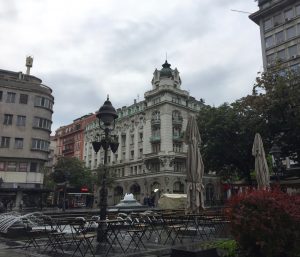
Downtown Belgrade
“Amerikanka” –that’s what I was called in Serbia. The first time I heard it, I laughed, but quickly grew fond of the word. Walking the crowded downtown streets, Renee suggested we speak softly (in English). I was surprised by her comment, but she said many people hadn’t forgiven America for bombing their city. That yes, it was technically a NATO bombing, but everyone thinks NATO is America. Renee added that people were crushed because America was always a land they admired and loved, and now they felt deceived, betrayed. “But what about the genocide, the ethnic cleaning, that Serbia inflicted?” I said.
This is where I would normally recap history and give a brief explanation of events that led to such a vicious war, but it’s complicated and revolves around ethnic hatred that dates back to the encroaching Ottoman Empire. This concept of ethnicity, and the centuries-old harboring of injustices that comes along with it, is hard for the average American to grasp. We live in the only true melting pot in the world. The majority of our forefathers came here to forget the past and all its grievances–not simmer in a stew of hatred. (As a cook, I love that sentence. As an observer of recent American culture, I see the tides turning.)
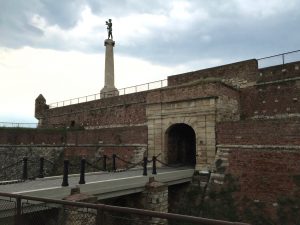
Turkish Fort
In the six republics of the former Yugoslavia, people strongly identified with their clans: Croats and Serbs, Slovenes and Bosnians, Montenegrins and Macedonians. They never melted; they never blended. They kept their languages and religions, which was not always an easy task in an atheist country. Due to these large differences and the insurgence of Serbian nationalism, most of the republics wanted out and lobbied for a federation of states instead. Serbia didn’t agree and wouldn’t negotiate. When Slovenia succeeded, followed by Croatia, Serbia declared it would support its own people, who lived throughout the land. That was their mandate to enter the former republics by force and duly, civil war broke out. (For an incredibly detailed timeline, read; http://academic.brooklyn.cuny.edu/history/johnson/balkans.htm)
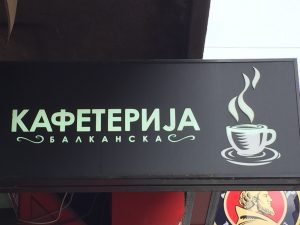
The Cryllic alphabet is alive and well.
By the time I landed in Serbia, the war had been over for 15 years; however a bombed out building near the train station, the Ministry of Defense, was deliberately left in ruin as a reminder of the injustice done to the people of Serbia. I stood in front of the ruble as men and machinery came in for the very first time to begin the cleanup. Belgrade and its leaders had been simmering the stew.
Another ingredient in the recipe — 30,000 Syrian refugees descended upon Belgrade last year. Some joked that the country wasn’t worried, though. They knew that the refugees would move on—Serbia offered no opportunity, no hope. The masses did depart for the north, but the memory of their arrival lingers.
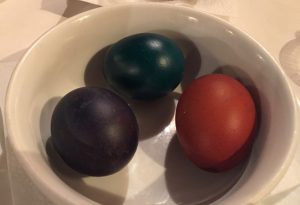
Orthodox Easter Eggs–We arrived just in time.
During my stay, I wanted to discover the country, not as a tourist, but as an avid historian who observes and contemplates people and their varying cultures. So, I walked the old town with its mix of Austria-Hungarian opulence and drab communism. I strolled through the nearby park and climbed the steps of a long-abandoned Turkish fortress to see where the Saba River flows into the Danube, eventually emptying into the Black Sea. Instead of focusing on this strategic spot that led to the founding of the city, I was fixated on the nearby vendors hawking t-shirts of Putin and war memorabilia. “Kosovo is Ours!” was emblazed on banners and shirts, sold next to Serbian flags, large and small. (Kosovo declared independence from Serbia in 2008.)
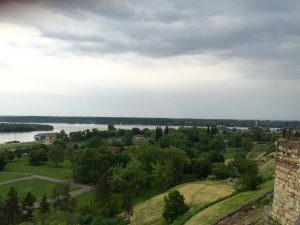
Where the Saba meets the Danube.
Downtown Belgrade is full of sidewalk cafés. It’s where people spend their evenings, discussing politics and life. It’s where I discovered their hardships–how the economy is stagnate, that work is hard to come by and the pay dismal. (Unemployment is now at 18%, down from a recent high of 25%.) Many complained about not having extra money, sometimes not even for a tank of gas…and this was the “white collar” crowd–the same people who protested in the streets when the current president, Tomislav Nikolic, came to power. Nikolic, a nationalist and outspoken admirer of Russia, had struck a chord with the growing underclass and disillusioned voters hit by hard times. Once a close ally of the former Serbian strongman Slobodan Milosevic, the last president of Yugoslavia and the man charged with crimes against humanity in the Balkan War, Nikolic campaign slogan was reminiscent of —“Make Serbia Great Again!”
Now, do you see where I’m going with this?
Please forgive the digression and be patient.
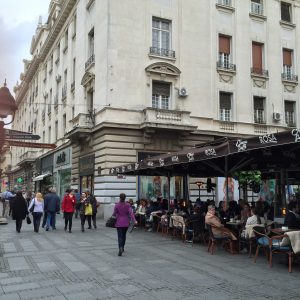
A pedestrian street with outdoor cafes.
Travel teaches us so much. Observing other people’s mistakes should also teach us; but it rarely does. Normally, I would write about the entertaining facts of travel and the wonderful food I discover along the way. In Serbia, it was burek–phyllo dough stuffed with fresh cheese and sometimes vegetables or spiced ground beef. I would also tell you how the smell of tobacco was overpowering in all the restaurants and that, until then, I had (thankfully) forgotten what it was like to have a meal in a cloud of smoke, but what I saw and felt on this particular trip was so much bigger and more important than all of this.
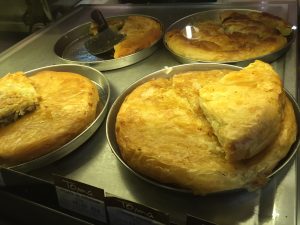
A selection of burek.
Nationalism is roaring its evil head again in Serbia. People are angry, just like in much of Europe and even here at home. History teaches us, though, that nothing good ever comes of nationalism.
I’ve been on a quest my entire life, not one of cooking or travel or self-discovering, but one that started with a simple question at the age of eight—Why does Grandma Kramer have a blue tattoo on her wrist? Grandma Kramer was my best friend’s grandmother. She didn’t speak much English, only Polish, and she baked and cooked and watched us sometimes after school. I was fixated on her tattoo. When I asked about it, my friend said she was in the Holocaust, but I didn’t understand what that meant. This is where my journey began though, my academic life without really being in academia. (Truth be told, I was too intimidated, and maybe a little lazy, to go for the Doctorate.)
By the time I was 10, I had read “The Rise and Fall of the Third Reich.” By the age of 12, I was studying German. In college, I studied WWII history, continuing my education in Germany. I took classes with former Nazi officers and Hitler Youth, because I wanted them to tell me—Why does Grandma Kramer have a tattoo? And even though I read all the books and knew the timeline of events, as well as spent a few holiday weekends visiting concentration camps instead of having fun with friends, I still didn’t understand how humanity could allow something like that to happen. I wanted answers—answers from the people who had lived it, the ones who had stood in agreement, as well as silence.
Does silence mean agreement? Where is the line? And does that line change when the stakes are higher? When your country is on a very dangerous path? Of course it does.
I didn’t think I’d see this dynamic in my lifetime, but I guess I give humanity too much credit. We’re not the brightest of creatures. We don’t learn from history, or the mistakes of others. The tide is turning in Serbia. I saw and listened to frightening stories in Hungary and Austria, recently, as well. And then I came home and saw it happening in America. What I had read in all those books, is now unfolding before my very eyes and instead of a sea of indignation, I see support and way too much silence.
I sit in dismay watching a completely unqualified man convince people that he’s a leader. I see how he takes people’s frustrations and despair and puts them into his large cauldron. He then stirs in the other essential ingredients: fear mongering, hatred, nationalism, scapegoating, ego, and misinformation spouted with extreme conviction. He preys on ignorance and the uneducated. If someone disagrees with his views, he stops everything to say, “Get him out of here!” —a textbook tactic of authoritarian leadership. Some people cheer his action, others laugh at it. But what I want to know is, where’s the outrage?
I see top politicians backing madness, some claiming that they can control the man. Their ignorance is shocking and it shows that they are as unqualified as he is. I don’t believe this man will become President. He’ll probably walk away in order to keep his inflated ego intact and his tax returns a secret.
My story, and this recipe for disaster, has nothing to do with Democrat versus Republican, right versus left. I take no stance here. My story is about recognizing the signs of danger before it’s too late and doing something about it, as in choosing a new party candidate. The time for laughing it off, as they laughed off Hilter in the 1920’s, is long over. He started as a joke, you know. A common bully stirring a pot of hatred, using the above recipe and insisting only he had the solution to the country’s discontent. This message would later be tailored and called The Final Solution. (If you don’t know what this is, please look it up.)
Supposedly, 40% of Americans stand behind this man and that’s what we, as a country, need to fear. We should fear ignorance and hatred. We should fear voters who are willing to throw their country and its people under the bus in order to amass huge personal wealth. The irony of this election is that the working class, via their segment of voters, is the strongest supporter of our 1%, and they don’t even realize it.
My story is about not being silent.
My story is about truly understanding why Grandma Kramer had a blue tattoo.

Trams in front of the Belgrade train station. Last summer, a sea of Syrian refugees camped out here.

